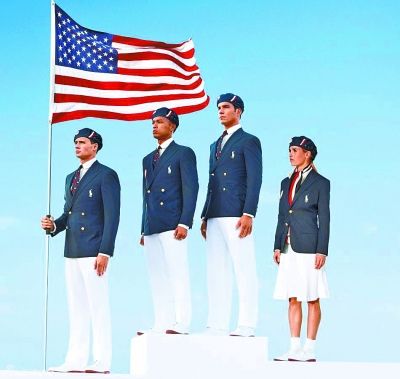Made-in-China Olympic resentment
- By Liu Daocai
 0 Comment(s)
0 Comment(s) Print
Print E-mail China.org.cn, July 21, 2012
E-mail China.org.cn, July 21, 2012
|
|
|
The U.S. Olympic uniforms were designed by U.S. label Ralph Lauren and made in China. [File photo] |
Controversy in the U.S. over the "made in China" official opening ceremony uniforms to be worn by the country's Olympic athletes are growing, even though the uniforms were designed by Ralph Lauren.
Some U.S. politicians have even suggested burning the uniforms and contracting the work to a domestic manufacturer.
This is obviously not the first time that U.S. Olympic athletes' uniforms have been made outside America. This time "Made in China" is being criticized by U.S. politicians mainly because of electoral timing. Before a presidential election, both Republicans and Democrats are looking for sensitive issues in order to lobby voters and divert attention from their own political shortcomings.
As China is one of the main destinations of U.S. offshore manufacturing, products made in China have a certain degree of political sensitivity. With U.S. unemployment hovering above 8 percent, American politicians frequently accuse China of stealing jobs.
Taking the U.S. Olympic uniforms as an example, which were designed by U.S. label Ralph Lauren and made in China, China's intensive and cheap labor force largely helped reduce the production costs. However, we still don't know how much the U.S. company paid Chinese workers who were at the bottom of the production chain while contributing the most labor.
An ongoing investigation regarding offshore payment of Adidas by the IOC (International Olympic Committee) is a similar case. As the biggest sponsor for the Olympics, Adidas established its tailoring factory in the suburb of Phnom Penh, the capital city of Cambodia, where workers are only paid an average salary of 15 U.S .dollars for working 60 hours per week.
Due to its expensive work force, a majority of American manufactures have moved to developing countries that have cheap and labor-rich factories. Goods made in China are both high in quality and low in price, which reduce American peoples' living expense while providing them with added convenience.
Given the reality of the irreversible trend of economic globalization and the unity of competitive sports, it's not the correct course of action to turn Olympic uniforms into political tools.
To tackle this offshore manufacturing problem, workers, capitals and the U.S. government need to negotiate for an agreement that workers will accept lower payment, companies willing to stay locally to develop core technology, and the government needs to promise to give policy support. Instead U.S. politicians blame China for manufacturing goods to evade their real domestic problems.
Most Chinese factories are just providing manufacturing services for multinational corporations, and labor force costs in China are only a twentieth of that in Europe. For China, adjusting industrial structures is key to realizing self-development in the long run.
(This article was first published in Chinese and translated by Guo Jiali.)
Opinion articles reflect the views of their authors, not necessarily those of China.org.cn.






